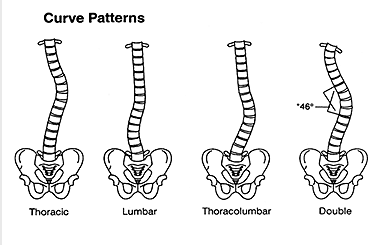scoliosis

Types of curvature in scoliosis.
Scoliosis is a curvature of the spinal column to one side, with twisting. It occurs as a congenital defect or may be secondary to spinal diseases including neurofibromatosis. Severe scoliosis, often associated with kyphosis, causes hunchback deformity, loss of height, and may restrict cardiac or lung function.
Types and causes
This condition typically starts in childhood and becomes progressively more marked until the age at which growth stops. In many such cases, any part of the spinal column curves toward the opposite side of the body to compensate for the scoliatic curve. The result is an S-shaped spine. The cause of juvenile scoliosis is unknown; if not corrected, it may lead to severe deformity.
Less commonly, scoliosis develops as a result of a congenital abnormality of the vertebrae, tilting of the pelvis due to one leg being shorter than the other, or poliomyelitis that has weakened the spinal muscles on one side of the body. Occasionally, an injury to the spine, such as a disk prolapse or ligament sprain, causes temporary scoliosis. In such cases, the spinal curvature appears suddenly and is accompanied by back pain and sciatica.
Diagnosis and treatment
Scoliosis is diagnosed by physical examination of the spine, hips, and legs, along with X-rays of the spine.
When the cause of the condition is known, treatment is aimed at the cause (for example, bed rest for a disk prolapse or wearing an orthopedic show with a raised heel to correct a pelvic tilt due to unequal length of the legs).
When the cause is unknown, the condition may not be treated if the curvature is slight. However, regular measurement of the spine is necessary to assess the progression of the condition. If the scoliosis seems to be worsening, or if the curvature is already pronounced, it may be treated by immobilization of the spine in a hinged plaster jacket or adjustable metal brace, followed by surgery and bone grafting to fuse the affected spinal vertebrae in a straight line. A steel rod with hooks may be used to keep the spine straight until the bones become fused.


